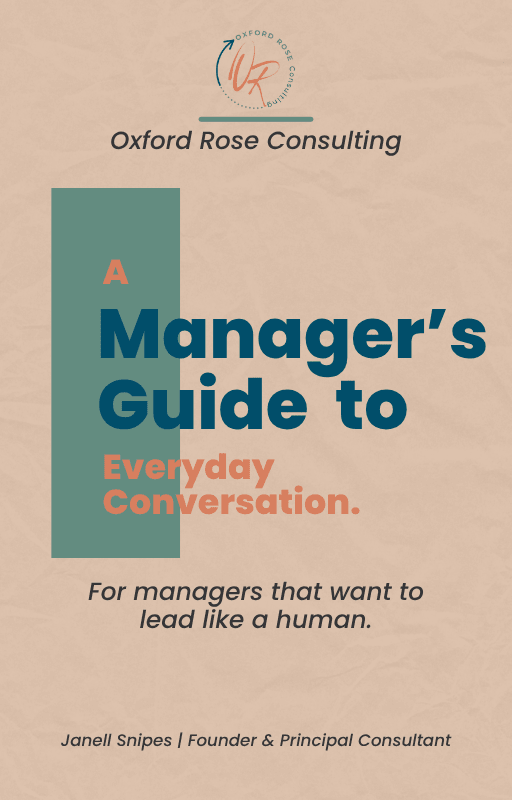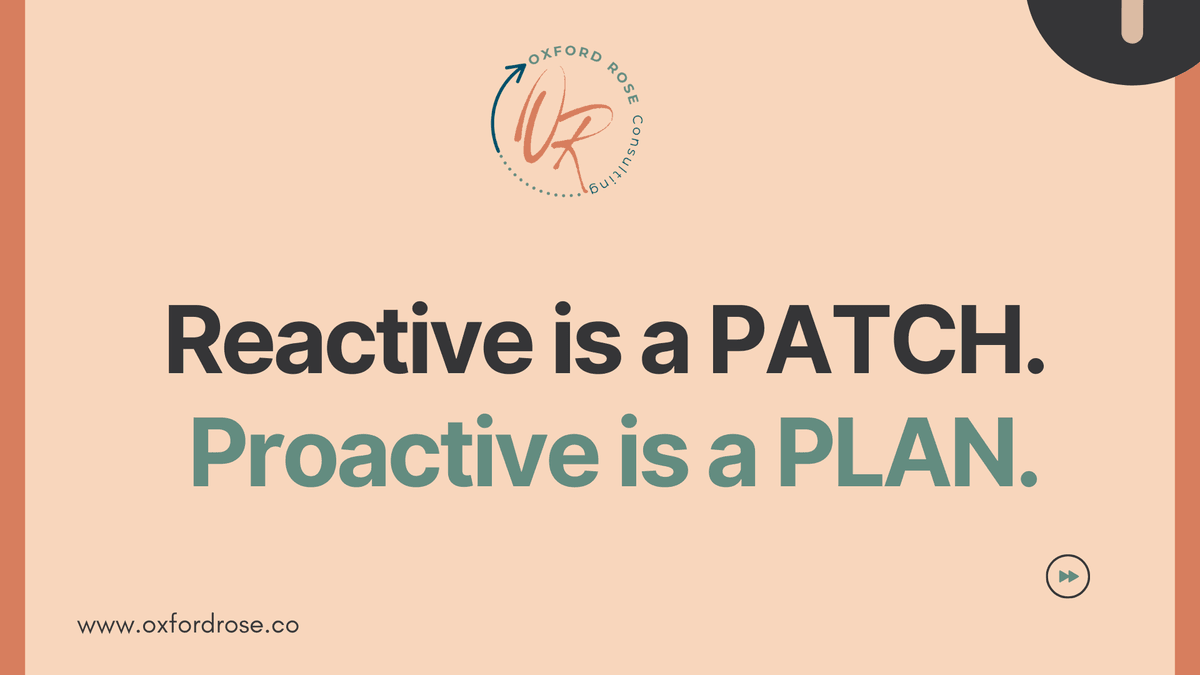

Innovate. Elevate. Succeed.
- …


Innovate. Elevate. Succeed.
- …


Oxford Rose Resources
Looking for tools, checklists, or insights to help you lead better? You’re in the right place.
This is where we keep practical resources designed to make HR and leadership easier, smarter, and more aligned with the way real businesses work.
Take what you need.
Come back often.
And if you’re looking for something specific, just reach out.

Stay Connected!
Sign up for a monthly resource straight to your inbox.
Recent Posts
Be sure to follow us on LinkedIn.

Culture is a Verb: Leading Change Before Change Leads You
In recent weeks, I have explored how much weight managers carry in shaping the employee experience—and the overwhelming response has confirmed what many of us already know: the behavior of leaders doesn't just influence culture; it is culture.
Culture is action; it’s the verb that drives behavior, productivity, and business results. And if leaders don’t lead culture, they risk letting culture lead them—down paths of disengagement, attrition, and missed opportunity.
Leaders set the tone, shift, and sometimes contaminate, the culture in four powerful ways.
What leaders tolerate.
Culture is compromised not by what you say no to; but what you silently allow. A leader that ignores behavior that is toxic, destructive, or divisive sends a louder message than any poster hanging on the wall.
How leaders handle the ‘gray’.
The leader’s approach to ambiguity shapes the emotional climate of the team. The team recognizes the behavior and language of their leader in the absence of specific instruction or information. Does the leader default to trust rather than suspicion, chart a path forward or stay stagnant, or react with curiosity instead of control? It all sends a message.
How leaders make people feel.
Many of us have heard the famous words attributed to Dr. Maya Angelou , 'people will forget what you said, but they won’t forget how you made them feel.' These words are key to building psychological safety in the team or organization. Respect, value, and appreciation are all delivered in the small consistent interactions between leader and team members, not just the big moments.
What leaders celebrate.
Recognition reinforces what “good” looks like. In performance management terms, what meets or exceeds expectations. The team will do more of what is celebrated or rewarded. If you reward output, don’t be surprised if people cut corners. If teamwork, transparency, and growth are rewarded, you will see more of it.
The data paints a reflective portrait of the manager’s impact and the value of organizational culture.
- 70% of the variance in team engagement is attributable to the manager. – Gallup
- Only 28% of employees strongly agree their manager consistently models their organization’s values. – Gallup
If you're waiting for a culture initiative to “kick off” before addressing the way leaders lead, you're already behind. Organizational culture is being role-modeled, displayed, and reinforced every day whether it is intentional or unintentional. The way that leaders show up models to the organization what is acceptable even if it isn’t desirable.
Culture impacts every aspect of an organization, including how team members:
- Experience working for the organization
- Speak to each other
- Collaborate as a team and across departments
- Handle challenges or conflicts
- Engage with innovation, risks, and mistakes
- Feel recognized and valued, and
- Express their ideas and concerns.
These cultural elements act as the invisible threads that weave through the organization, connecting every action, decision, and interaction.
According to Deloitte, 82% of HR and business leaders believe culture offers a real competitive edge—yet only 12% feel they’re cultivating the right culture.
So how is the “right” culture cultivated? Let’s explore 5 steps to help align and activate your cultural goals.
- Identify your cultural goals. Name the culture that you want and be specific.
Great founders and leaders often start with a mission, vision, or purpose statement. These statements serve as the guiding light and foundation of what the organization exists to do. These statements may help direct you to how you may want to attain the big picture. If descriptors such as ‘customer-centric’ are included, think about what it would take to make the customer the priority in all aspects of your business.
Write the goals down.
2. Visualize your aspiration and document what makes it tangible
Words written on paper or posted on a placard are only words until life is breathed into them. Take time to map out what the words mean, how the cultural goals will show up in behaviors and interactions, and what impact the behaviors will have on the environment. Connecting behaviors and values to cultural goals is what helps your team to understand, enact, and embody the desired culture in their daily work and interactions.
3. Assess and Reflect
Conduct a listening tour to find out whether the culture you aspire to is the one you currently have. Pulse surveys, group interviews, and quick sentiment check-in’s can be used to gather data and help further the conversation. Be mindful that your team will only engage to the point where they feel safe; this part of the process may be difficult if psychological safety isn’t present in your current cultural state.
Show up in personal conversations with genuine curiosity, listening ears, and low defensiveness. These behaviors will be essential to getting information to help determine the path forward.
As you reflect on the feedback and data gathered, identify the gaps in what is present verses what is aspired. The gaps will shape your roadmap forward. And don’t forget to show real-time responsiveness since you have started asking questions. Keep team members engaged in the process by communicating what you have learned and what you plan to do. Silence becomes consent if things are not addressed in a timely fashion, and your team will view all the conversations as just talk.
4. Communicate and Model
Being successful in shifting cultural behaviors takes an intentionality. Based on the phase of the business life cycle that you are in, your change management process may differ. A clear communication strategy is going to be the lynch pin to your success. Team members need to be informed, aligned, and prepared to enact the behaviors that will serve as the foundation of your new organizational culture.
Leaders must support ongoing communication and model the identified behaviors consistently. When they mess up, and many will, they should own it. Vulnerability drives credibility. Remember, the team is watching. Tell stories that reinforce the culture and cultural transition. Sharing real moments that highlight the team living out the cultural goals will make the behaviors stick.
5. Audit and Align Systems
Culture thrives when systems align with the desired behaviors. Review the organizational policies and practices that directly impact engagement and employee experience. Review current systems such as hiring and promotion practices, performance reviews, reward structures, as well as meeting and communication norms to identify if they align and support the cultural goals and desired behaviors.
Culture is something that you do. It needs consistency, accountability, and most of all, action. Culture lives and thrives in habits.
Culture isn’t optional; it will either be cultivated with intentionality and supported by daily action or it will create itself in the void.
Culture doesn’t wait for a kickoff meeting; it’s happening right now, in every hallway conversation, instant message, team huddle, and leadership decision. It’s the sum of your behaviors, not your branding. As a leader or manager, you don’t just impact culture, you are the culture. So, the question isn’t whether you’ll shape it, but whether you’ll shape it intentionally. Step into that responsibility with clarity and courage. Because when leaders own the culture they create, they unlock the trust, energy, and alignment that fuel real progress. And that’s where magic, and the momentum, begins.
#Leadership #OrganizationalCulture #PeopleStrategy #HRConsulting #PsychologicalSafety #CultureInAction #CultureIsAVerb, #Leadership, #HRStrategy

Connecting Beyond the Small Talk.
❓ ❓ Do you actually talk to your team members? ❓ ❓
This sounds like a far fetched question to ask a leader/manager/supervisor or other people leader right?
I think that most 'leaders' chit chat with their teams to keep friendly relations going but that's not exactly what I'm talking about.
I'm asking about real conversations on topics that establish a deeper connection and have a positive impact on the participants.
Research shows that:
😃 82% of employees felt they would be more engaged if they had more meaningful conversations with their bosses more often
🤓 78% said they’d be more likely to share their ideas
☺️ 76% would more likely look for career growth in their company, and
🥳 75% would more likely stay with their company
If a real conversation are that impactful on the employee experience and the organizational loyalty factors, what is getting in the way?
Many managers avoid conversations because they:
🤦♂️ Aren’t trained to have the conversations
🤦♀️ Aren’t prepared to dig deep
🤦 Are concerned they can’t meet expectations established in deeper conversations
Many of us avoid the things that we don't feel equipped to do. We continue to skim across the surface so that our knowledge or status isn't questioned EVEN THOUGH it is much easier being a regular human that doesn't have all of the answers.
I've coached managers through difficult team situations where communication was non-existent, not even the chit-chat was happening with some team members. After rebuilding many bridges, this became clear to me: it is so much easier to have the hard conversations when the easy but meaningful conversations happen regularly.
Conversations matter! Connection matters!
Learning to communicate with your team is a process that can only be perfected with consistency; so I encourage you to start today.
Here are 3 lead-in questions that can help you get beyond the chit-chat and open the door to more meaningful engagements:
1. "What’s one thing you’ve been working on that you’re really proud of—but that might be flying under the radar?"
This gives you insight into what motivates the team member and highlights areas that you can show appreciation for their contributions.
2. "Is anything slowing you down right now that I might not be aware of?"
This helps to identify obstacles or frustrations without putting the person in defense mode. If you have a way to assist them, it can also set you up as the manager advocate that will help their work lives be a little easier.
3. "What’s one thing I could do more—or less—of to support you better?"
This changes the conversation from performance management to partnership and gives the employee permission to give upward feedback.
These tips can help you go beyond the break room banter and dig deeper (professionally) faster.Check out the Resources page for the downloadable Manager's guide.

Proactive is a Plan.
I'm sure that in your career, you've encountered the evidence of an issue that was ignored for far too long.
Recently, I was talking to a family member who lost a co-worker in a work accident. She said, "everyone knew..."
🛑 'Everyone knew' that procedures weren't being followed.
🛑 'Everyone know' the the forklift was stacked too high.
🛑 'Everyone knew' that the he didn't play by the rules.
🛑 'Everyone knew' that the supervisor didn't hold him accountable, because if she did, he shouldn't have been working there anymore.
Unfortunately, now everyone has to deal with the grief of losing a co-worker that was an innocent in the whole scheme of things. And the leadership HAS to do something in the aftermath.
This phenomena shows up in organizations of all sizes, where backs are turned, whispers ignored, and maybe there is a leader sitting in an office somewhere hoping that the issue will "resolve itself".
Unfortunately, sometimes the resolution is a disastrous finale that finds it's way the front page news. Other times it is the loss of great team members who were tired of standing by waiting on a 'leader' to resolve it, so they find there way to another organization.
In all of my "HR-ing", I have heard the stories out of the mouths of team members sitting in my offices and from friends and family seeking advice about how to escalate an issue in their company.
The truth of the matter is that many times FEAR holding back the most concerned person from taking action. FEAR that they may be shushed, condemned, blackballed, retaliated upon, and lose any future options within their organization.
📢 THIS IS A WORKPLACE CULTURE ISSUE.
📢 THIS IS A LEADERSHIP ISSUE.
📢 THIS IS A RISK ISSUE.
The goal of Oxford Rose Consulting is to help organizations operate PROACTIVELY.
Don't get trapped in status quo behavior and if you are a leader, don't let status quo behavior become the norm.
Time out for 'We need to do something about this'. Action is needed now.
Let's get proactive and create climates where honest feedback is the expectation and the foundation for a phenomenal and safe workplace.
Hiring Smart is Survival
📢 📢 Hiring SMART is the BEST choice. 🎆
Organizations trying to scale their business and workforce often rush to fill seats when demand spikes.
We all can agree- growth is THRILLING.
But if your hiring process is reactive and vague, you're building a house on sand. Rushing to get the warm bodies that you'll 'train along the way' is not a strategy, it's a bandage.
I've seen this play out:
- No clarity on role outcomes
- No structured interview process
- Lack of alignment between the hiring manager and the recruiter
Three months later, the same role is open again. Team morale is down 😔 and everyone is frustrated 😫.
Here's a quick rule of thumb:
1. Do the internal work first; get everyone aligned and ready to hire.
2. Don't hire the perfect fit, hire the candidate also ready for growth.
AND MAKE SURE that your onboarding process is NOT an afterthought.
💡 Want a quick start hiring audit? DM us. It's proven to save a lot of churn and cost.
The Manager & Leader Connundrum
Genuine human connection often gets overlooked as the most powerful lever for organizational leadership and growth.
Think about it. How often have you felt truly inspired or motivated by a leader who took the time to really listen? Or found a business partnership flourish because it was built on mutual respect and understanding, not just a contract?
For me, whether I'm advising a executive or collaborating with a new client, the foundation is always the same: seeing the person first. It's about asking thoughtful questions, actively listening to the answers (even the unspoken ones), and building rapport that goes beyond the transactional.
This isn't about forced networking or collecting contacts. It's about:
*️⃣ Empathy: Trying to understand the other person's perspective, challenges, and aspirations.
*️⃣ Authenticity: Showing up as your true self, fostering trust and openness.
*️⃣ Active Listening: Truly hearing what's being said, not just waiting for your turn to speak.
*️⃣ Shared Value: Focusing on how you can genuinely help or contribute, rather than just what you can gain.
In leadership, these genuine connections translate to more engaged teams, increased loyalty, and a culture of trust. In business, they lead to stronger partnerships, more effective collaborations, and ultimately, better results.
So, this week, I encourage you to take a moment to connect with someone on a deeper level. Put down the agenda, silence the notifications, and have a real conversation. You might be surprised by the power it unlocks.
Telephone:
484-275-0919
Email:
hello@
support@
© 2025 Oxford Rose Collective
A division of The Andever Group, LLC





